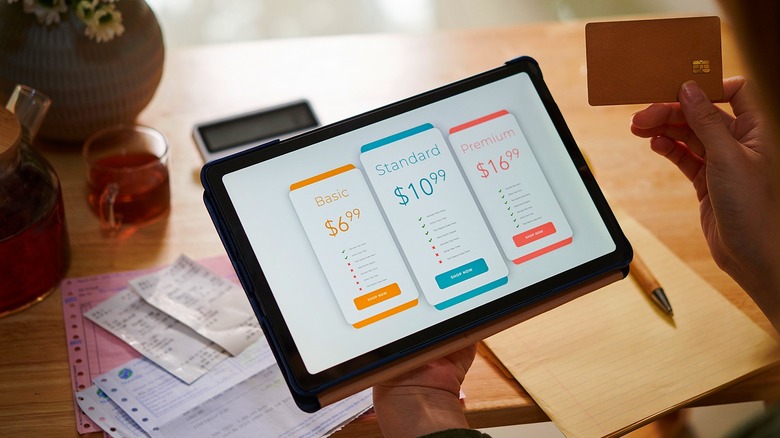Using Autopay For Your Subscriptions Could End Up Costing You
Using autopay is a convenient way to keep current with all your bills. It's often used for monthly payments for mortgages, cable, internet, mobile services, and utilities, and with it, you never miss a payment and you're never late to incur regrettable late fees. Autopay is also used for subscription services, of course, with many companies these days requiring this payment option in order to enroll at all. But, while convenient, automatic payments can also end up costing you, especially when it comes to subscriptions you've forgotten about and no longer use.
In a survey by Chase (conducted by SWNS OnePoll in the spring of 2021), 2,000 U.S. consumers were asked about their habits related to recurring payments, such as subscriptions. Sixty percent of respondents said they had forgotten about a recurring monthly payment (in the past year), while 55% noted they weren't sure how much they were being charged each month via recurring payments. In such cases, it would seem that setting it and forgetting with autopay might not be the best budget strategy.
Autopay makes it easy to forget
In its 2022 survey, Chicago-based market research company C+R Research surveyed 1,000 U.S. consumers about their relationship with subscription services and recurring charges. The company found consumers underestimated how much they spent every month on subscriptions by an average of $133. What's more, 72% of the respondents said they set all their payments to autopay, while another 14% said they set some.
Among the generations, when it came to forgetting about a subscription but still (automatically) paying for it, baby boomers were best at keeping track of what they were paying for. On the other end, Generation Z, at 55%, was most likely to continue paying for a subscription they forgot about, while millennials and Gen X were a bit better at 48% and 43%, respectively. Overall, 74% of the respondents admitted that it was easy to forget about recurring monthly subscription charges.
Autopay, of course, makes this easy, especially if the subscription isn't one where you're sent a reminder, such as a box of pet treats on the 15th of every month. But a gym membership, an online course, a professional network, or a streaming service you only wanted to try for the free trial, such subscriptions can easily be forgotten about. Consider, even if it's only one subscription, one that charges you $14.99 a month, if you don't realize for a whole year, that comes to $179.88.
Auditing your autopay subscriptions
Not knowing about existing subscriptions set to autopay can seriously cost you. As said, just one subscription at $14.99 will cost you nearly $180 in a year. What if you have more than one? To get a handle on your subscriptions and only keep the ones you truly want (and can budget for), do a full audit of your banking statements for the month and note any recurring payments. Make a list and decide on which to keep and which to cancel.
Also, some subscriptions, like a newspaper, might be annual. So you may need to backtrack and search statements for the entire year. You could also search your emails for welcome messages or renewal reminders. However, according to Andrew Pierce, CEO of legal technology firm Company Sage, you can avoid this task by not setting annual subscriptions to autopay at all. "It is too easy to forget about annual bills and you may not have budgeted for them," he said to GOBankingRates.
Finally, once you've sorted your subscriptions, look into a subscription tracker, such as Rocket Money (formerly Truebill) or Mint, to stay on top of your subscriptions and their recurring charges. Note that these tracker websites/apps typically aren't free, unless they're through your credit card company, like Chase. Alternatively, you could also create your own tracker with a spreadsheet.


